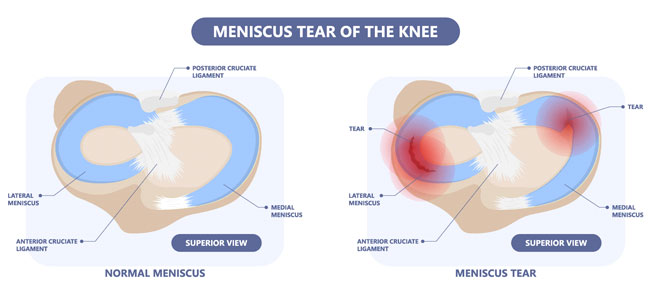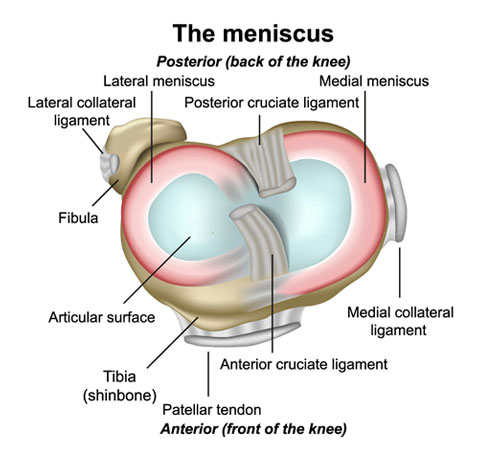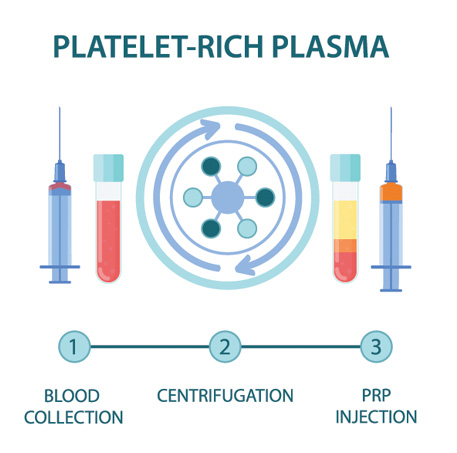Meniscal Tears
What is a meniscal tear?
The knee has two C-shaped cartilaginous structures called the menisci. They sit between the femur (thigh bone) and tibia (shin bone) and act as a cushion for the knee joint. A meniscus can sometimes incur a tear and be a source of knee pain.

What causes a meniscal tear?
Acute meniscus injuries may occur due to twisting, cutting, or rotating the knee. Additionally, a meniscus can undergo more gradual degenerative changes with tears over longer periods of time.
How is a meniscal tear diagnosed?
Patients with meniscus tears may present with focal knee pain, often localized to the medial (inside) or lateral (outside) aspect of the knee depending on which meniscus is the source of pain. They may also note mechanical symptoms such as catching, locking, or popping at the affected knee. Physical examination may reveal focal tenderness at the joint line, swelling at the knee, pain with hyperflexion of the knee such as in a deep squat, or reproduction of pain with a variety of provocative tests. X-ray or magnetic resonance imaging (MRI) may aid in confirmation of diagnosis.

How is a meniscal tear treated?
Initial treatment options for management of a meniscal tear may include medications and physical therapy. Physical therapy should primarily focus on hip, glute, quadriceps, and hamstring strengthening. If a patient is still experiencing significant pain despite the aforementioned treatment options, interventional options may include corticosteroid (cortisone) or platelet rich plasma (PRP) injections. Finally, referral to orthopedic surgeon skilled in knee arthroscopy/sports medicine may be considered for further evaluation and consideration of surgical intervention.
Corticosteroid Injection
Using ultrasound, a needle is carefully and precisely guided to the knee joint capsule. Once the knee joint has been accessed, a steroid solution is instilled through the needle and into the joint capsule to coat or bathe the joint with anti-inflammatory medication. This helps to decrease inflammation and, subsequently, decreases pain and improves function.
Platelet Rich Plasma (PRP)
PRP is component of the patient’s own blood. It is rich in growth factors and other cells that signal an increased healing response to a damaged tissue. It is used to treat a variety of painful spine and musculoskeletal conditions.
Blood is drawn from a patient and then placed in a centrifuge for it to be “spun down.” This causes the different components of the blood to separate out in the vial. The PRP solution is then drawn up into a syringe and prepared to be injected at the site of the patient’s injury.

Discontinue use of all non-steroidal anti-inflammatory drugs (NSAIDs) at least 7 days prior to the procedure. These may include ibuprofen (Advil, Motrin), naproxen (Aleve), meloxicam (Mobic), diclofenac (Voltaren), indomethacin (Indocin), and celecoxib (Celebrex). If you are taking oral corticosteroids such as prednisone or a Medrol Dosepak, please discuss this with Dr. Best prior to your procedure. In some cases, Dr. Best may request that the corticosteroid medication be discontinued in preparation for the PRP injection. Do NOT stop aspirin unless specifically instructed by Dr. Best. Depending which body part is injected, you may need a driver to and from your procedure. If you have any questions or concerns about whether to continue or discontinue any of your medications leading up to your PRP injection, please discuss these issues with Dr. Best and his team.
Once the PRP solution is created, the patient is positioned for the procedure. The skin is thoroughly cleaned and the target for the injection obtained with ultrasound or fluoroscopy (x-ray). Then, a numbing solution is injected at the skin and subcutaneous tissues for increased procedural comfort. Finally, under ultrasound or fluoroscopic (x-ray) guidance, the needle is guided to the injury site and the PRP solution is deposited.
It is common to experience mild to moderate pain or discomfort during the initial 0-3 days after the PRP procedure. Post-procedure pain can be easily managed with acetaminophen (Tylenol) or other non-NSAID pain medication. Try to avoid applying ice or heat to the injection site.
During the 3–14-day period after the PRP injection, you may gradually increase physical activity. Please continue to avoid use of NSAIDs; however, ice may be applied for short periods of time throughout the day to aid in management of post-procedure soreness/discomfort if present.
During the 2–4-week period after the PRP, Dr. Best may recommend initiation of a course of physical therapy to aid in recovery and optimization of healing. The patient may begin to note improvement in pain during this time period, though it often takes 1 month or more for the benefits of PRP to take hold.
At this time, PRP injections are not typically covered by any insurance companies. Pricing and payment options can be discussed with Dr. Best and his team prior to your procedure.
As an alternative to PRP injections, intra-articular knee joint injections with corticosteroid can be performed to help alleviate knee region pain. Using ultrasound, a needle is carefully and precisely guided to the knee joint capsule. Once the knee joint has been accessed, a steroid solution is instilled through the needle and into the joint capsule to coat or bathe the joint with anti-inflammatory medication. This helps to decrease inflammation and, subsequently, decreases pain and improves function.
At a Glance
Dr. Craig Best
- Harvard Fellowship-Trained Interventional Spine & Sports Medicine Specialist
- Double Board-Certified in Physical Medicnie & Rehabilitation and Pain Medicine
- Assistant Professor of Physical Medicine & Rehabilitation and Orthopedic Surgery
- Learn more

